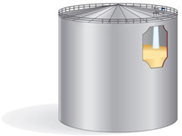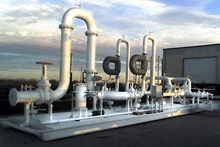
Rossella Mimmi
Oil & Gas Industry Manager, Flow Solutions Group
The economic impact of custody transfer in the oil and gas industry is huge. Transferred fluids are expensive, so producers, carriers and end users want to make sure that quantity and quality are measured very precisely.
Also, as taxes and royalties are calculated on these values, measurement accuracy and reproducibility are important.
There are two methods mostly used for custody transfer of liquid hydrocarbons at the well pad: tank gauging or dynamic measurement with LACT units.
Tank Gauging
 Tank gauging has been used for a very long time. It is well accepted by the industry and involves a volume assessment of liquid products in a tank in static conditions – meaning that no liquid can enter or leave the tank during the measurement. The main quantities necessary to perform the volume calculation are the fluid level and temperature that are typically measured manually, in cases where wireless devices have not been installed, and density, which is usually measured on site with hydrometers.
Tank gauging has been used for a very long time. It is well accepted by the industry and involves a volume assessment of liquid products in a tank in static conditions – meaning that no liquid can enter or leave the tank during the measurement. The main quantities necessary to perform the volume calculation are the fluid level and temperature that are typically measured manually, in cases where wireless devices have not been installed, and density, which is usually measured on site with hydrometers.
Some uncertainties, however, are associated with tank gauging, for example:
- Tank issues: Tanks aren’t perfect shapes and their shape is going to be modified during the tank filling. Thermal expansion, sediment build up, and errors in tank capacity tables are other sources of uncertainties.
- Temperature measurement: Horizontal and vertical stratifications in the tank make it very difficult to get an accurate temperature measurement. A typical error in manual measurement is 2-3degF, and this can cause a 0.1% error in the volume calculation.
- Level measurement: Incorrect reference points or simply incorrect measurements cause problems. Typically the influence on the volume is 0.8-2.5%, but one of our customers reported a huge 7% error in volume calculation due to level misreading.
There are other issues related to tank gauging, the most important one is safety. These manual measurements require for the operations staff to climb on top of tanks–a difficult procedure performed in hazardous locations where personnel can be exposed to dangerous fumes.
The final consideration is that overall uncertainty in tank gauging can be up to 1%. To better understand the impact of this value, we can consider that the potential annual exposure at a production rate of 1,000 barrels per day will be almost $250k.
Dynamic measurement with LACT units
A LACT unit has many devices and instrumentation installed and all play an important role in the measurement performance. In fact, it’s really the overall system that brings all the equipment together to ensure the required accuracy, sustainability, and reliability of the custody transfer measurement.
What are the main challenges associated to these systems? We identified the following:
- Application challenges: This is not an easy application for the flow meter; the environment is harsh, the fluid is not a clean and easy to measure, and both operating conditions and fluid properties can change quickly.
- Sustain performance and reliability: Given the critical nature of the measurement, it’s important to make sure the measurement is accurate and reliable in the long term.
- Remotely control the process: As these units are located in remote locations and are unmanned, it’s important to be able to remotely collect data and information that can help gain better insight into the system and better manage it from afar.
Several solutions exist that help overcome these challenges.
- As with many oil and gas applications, selection of the right technology for the application is critical. Many technologies are available for custody transfer applications but the choice of the right technology will ensure better meter performance with changing conditions and fluid contaminants, reducing measurement uncertainty and ensuring fiscal assurance. This also helps reduce the amount of time and money spent on additional maintenance. The use of new technology like Coriolis meters can also enable continuous insight into oil quality; information like density, drive gain, and volume flow rate can help detecting abnormal fluid conditions such as entrained gas or paraffin build up.
- As custody transfer flow measurement must be accurate and reliable in the long run, proving and calibration activities for the flow meters are very important. Several methods are available, from traditional pipe provers to compact provers and master meters and each has its own characteristics to ensure accuracy, flexibility, repeatability, or cost reduction. The choice will depend on the specific application and the business goals.
- Control and data management can optimize operations and maintenance programs. A huge amount of data is available from devices and instrumentation; in addition, new technologies can provide supplementary information such as a meter’s advanced diagnostics, alarms, and historical proving data. These data have to be collected and analyzed to gain a better insight into the system, enabling faster troubleshooting and proactive maintenance.
As there can be an initially high initial investment for meters and provers in a LACT system, such a system is not economically convenient if the flow rate is too low, typically <100 barrels per day.
However, for higher flow rates, LACT units for custody transfer offer measurement accuracy of 0.25% or better. This comes from not just the meter, but from the choice of all the necessary instrumentation and devices that are integrated in a system. Flexibility is another benefit with 24-hour operation that can be scheduled, even if the oil is in movement to or from the tanks. LACT units can be fixed or installed on the truck, and optimized load capacity provides cost savings on truck operation that, in turn, increases transport efficiency.
From Jim: You can connect with other oil & gas and flow experts in the Oil & Gas and Flow groups in the Emerson Exchange 365 community.





